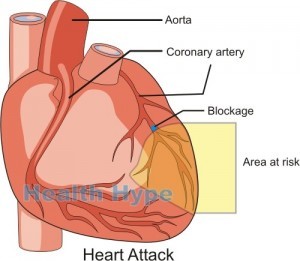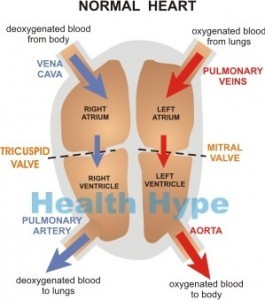Heart Symptoms Reasons, Types of Diseases and Warning Signs
There are many different types of heart diseases which may be due to a host of causes. As a result, symptoms in and around the heart would be present. However, all of these conditions affect the functioning of the heart meaning that the circulation of blood in the body is impaired. Therefore some of the symptoms that arise are not only at the source of the problem, the heart, but also elsewhere in the body.
Reasons for Heart Symptoms
Some of the different types of heart problems include:
- Blocked artery where the coronary artery supplying blood to the heart becomes narrowed and eventually blocked leading to damage and death of heart muscle (heart attack).
- Weak heart where the heart’s ability to pump blood is suddenly or gradually diminished for various reasons, including a heart attack. This weakening is known as heart failure.
- Enlarged heart occurs when the heart has to work harder than usual or where the heart muscle becomes diseases or damaged. This is known as cardiomegaly and may be caused by a range of heart diseases.
- Heart infection may affect any of the layers of the heart. Infection of the inner lining is known as endocarditis, of the middle muscular layer is myocarditis and of the outer layers is pericarditis.
- Heart valve disease where the valves that separate different areas of the heart does not function properly thereby allowing for leakage.
Read more on the different types of heart diseases.
How the heart works?
As is well known, the heart is the muscular pump that circulates blood throughout the body. However, there are many phases and processes for the heart to function normally. Low oxygen blood flows into the right side of the heart, specifically into the right atrium. Then the right atrium contracts and sends the blood into the right ventricle.
The right ventricle then contracts and sends this blood to the lungs where it is oxygenated. The now oxygen-rich blood flows back to the heart into the left atrium. From here the blood is pushed into the left ventricle when the left atrium contracts.
Eventually blood is pushed out of the heart when the left ventricle contracts and then blood is sent throughout the body. There are several valves between the chamber of the heart (atria and ventricles) as well as between the blood vessels leading into and out of the heart chambers.
The entire process is controlled by sinoatrial node, which is also known as the heart’s natural pacemaker. Here electrical signals originate and are then distributed through the heart muscle in a manner that allows for the atria to contract first, and then the ventricles.
Read more about cardiac output.
Symptoms of Heart Problems
Some heart problems can be asymptomatic (without symptoms) especially in the early stages. In other cases serious heart conditions can present with mild symptoms. Therefore the intensity of the heart symptoms is not always the best indicator of the seriousness of the underlying cardiac condition.
Chest Pain
Chest pain is commonly known to be typical heart symptom but it is not present in all cardiac problems. In conditions like a heart attack (myocardial infarction) the central chest pain is described as crushing or suffocating in nature. Sometimes it can mimic heartburn and is therefore mistaken for acid reflux.
Read more about cardiac chest pain.
Arm Pain and Other Pain
When chest pain is present as a heart symptom, it may also be accompanied by left arm pain. The other areas where pain may be experience includes the neck, jaw and upper middle abdominal pain. Sometimes the pain in these areas can occur on its own even without chest pain.
Difficulty Breathing
With the heart not circulating blood properly, oxygen is not distributed through the body as is required by the cells. The blood is also not circulated efficiently through the lungs for oxygenation. These effects result in low blood oxygen levels which is perceived as shortness of breath or difficulty breathing (dyspnea).
Paleness and Blue Skin
A low blood oxygen level along with low blood pressure can cause paleness throughout the body. This paleness (pallor) can eventually progress to a bluish tinge (cyanosis). In severe cases the skin may appear a pale greyish blue color if medical treatment is not forthcoming.
Dizziness and Fainting
The brain is highly sensitive to a drop in blood oxygen levels and blood pressure. The low circulating oxygen and reduced blood pressure to the brain results in a lightheaded feeling at first. This can progress to dizziness and as the condition worsens it may lead to fainting.
Excessive Sweating
Another common heart symptom seen with conditions like a heart attack (myocardial infarction) is excessive sweating. This occurs as a result of sympathetic nervous activity which is triggered by the heart attack. The perspiration is profuse and does not correlate with environmental factors like heat.
Palpitations
Palpitations are an indication of the heart working harder than it normally would. It is felt as a pounding or throbbing in the chest and often the heart is beating faster than normal as well. This is usually a result of the heart trying to work harder to distribute oxygen due to its functional impairment with an underlying heart disease.
Fluid Retention
Fluid retention may occur in various heart diseases as the blood return to the heart is impaired and congestion in the blood vessels causes fluid to leak out into tissue spaces and cavities. It is further compounded by reduced blood flow to the kidney which reduces kidney function and lead to salt retention. This promotes fluid retention.
As a result, this fluid retention may be seen as swelling particularly in areas like lower legs and feet. It may also seen as fluid accumulation in the lungs known as pulmonary edema which can lead to abnormal breathing sounds and dyspnea (difficulty breathing).
Warning Symptoms
Immediate medical attention is necessary when there is any suspicion that the onset of symptoms may be related to a heart condition. Chest pain, difficulty breathing and dizziness should be taken seriously even if these symptoms occur independently of each other.






